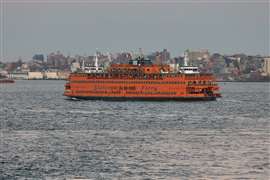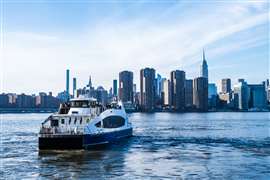NYC to test renewable diesel in ferry services
19 November 2024
Officials in New York City (NYC) recently announced the city will begin testing renewable diesel fuel on the Staten Island Ferry and NYC Ferry. NYC Ferry will also launch a short-term plan to upgrade engines on its largest vessels to reduce emissions.
The New York City Dept. of Transportation (NYC DOT) will test the renewable diesel on the Marchi Staten Island Ferry boat as a direct replacement to the ultra-low sulfur diesel (ULSD) currently used in the ferry fleet. NYC DOT said it plans to expand renewable diesel to the full Staten Island Ferry fleet in 2025, resulting in an estimated 60 percent reduction in the fleet’s carbon dioxide (CO2) emissions.
 The Staten Island Ferry, July 11, 2024. (Photo: ddp/dts Nachrichtenagentur via Reuters Connect)
The Staten Island Ferry, July 11, 2024. (Photo: ddp/dts Nachrichtenagentur via Reuters Connect)
The Staten Island Ferry carries almost 24 million passengers annually between Staten Island and Lower Manhattan. NYC DOT said that Staten Island Ferry emissions represent 15 percent of municipal government transportation emissions, while emissions from fuel use for ferry vessels comprise 94 percent of the ferry system’s greenhouse gas (GHG) emissions.
Ydanis Rodriguez, commissioner of NYC DOT, said the city was looking forward to reducing the carbon footprint of the Staten Island Ferry, which he characterized as the busiest municipal ferry service in the country.
“The transportation sector is responsible for nearly 28 percent of greenhouse gas (GHG) emissions in our city, but that means it can also be a key part of the solution,” he said. “Reducing dependence on fossil fuels offers a key step toward a greener and healthier New York City.”
Meanwhile, the New York City Economic Development Corporation (NYCEDC) and NYC Ferry will launch a six-month pilot program using renewable diesel fuels on select vessels, NYC DOT said, intending to transition the entire fleet to renewable diesel in 2025.
The NYC Ferry system offers six routes spanning 70 nautical miles and provides transit across New York City’s five boroughs to more than 7 million riders annually.
According to Louis A. Molina, commissioner of the New York City Department of Citywide Administrative Services (DCAS), the use of renewable diesel on the ferries contributes to their environmental friendliness.
“This groundbreaking initiative not only cuts greenhouse gas emissions by using renewable resources but also aligns with our larger vision for a greener municipal fleet,” he said.
NYC Ferry Fleet Upgrades
In addition to the use of renewable diesel, NYCEDC and NYC Ferry will begin the process of upgrading 13 of the system’s largest vessels — each carrying 350 passengers — to meet the U.S. Environmental Protection Agency’s (EPA) most stringent Tier 4 emission standards. These conversions will reduce pollutants like nitrogen oxides (NOx) and particulate matter (PM) by up to 65 percent, NYC DOT said.
 The NYC Ferry on the East River, Dec. 16, 2023. (Photo: Pierre Larrieu / Hans Lucas via Reuters Connect)
The NYC Ferry on the East River, Dec. 16, 2023. (Photo: Pierre Larrieu / Hans Lucas via Reuters Connect)
Andrew Kimball, president and CEO of the New York City Economic Development Corporation (NYCEDC), called the move a step forward in making harbor operations more sustainable.
“As we continue to break ridership records at NYC Ferry, it’s critical that we not only take immediate steps to reduce the emissions from our vessels but think strategically and holistically on how to create a more sustainable system across the board,” he said.
NYC DOT said these developments are part of a broader sustainability strategy aimed at transitioning the NYC Ferry fleet toward zero- and reduced-emissions vessels. As part of this, NYCEDC will begin a study focusing on the vessels themselves as well as changes to shoreside infrastructure required to support their operation. The study is expected to conclude in late 2025.
A Larger Initiative
Renewable diesel, also known as hydrotreated vegetable oil (HVO) in Europe, is a drop-in replacement for fossil diesel fuel.
“There are no molecules in the HVO that you don’t find in diesel fuel, so it is chemically very similar, except that it’s missing some of the nasty stuff that doesn’t burn cleanly,” said Markku Honkanen, head of technical services for renewable fuel maker Neste, based in Espoo, Finland.
In September 2023, New York City became the first city to begin transitioning to renewable diesel on the U.S. East Coast, according to NYC DOT. Since then, renewable diesel has replaced more than 12 million gallons of fossil diesel and has already been used to power the city’s fleet of garbage trucks, ambulances, work trucks, emergency generators, and more.
The use of renewable diesel in select Staten Island Ferries and NYC Ferry vessels builds on the recent announcement that all of New York City’s 12,500 heavy-duty and off-road vehicles have completed the transition to renewable diesel. This makes New York City the first major East Coast city to implement this green technology at such a large scale, NYC DOT said.
In announcing the milestone, New York City Mayor Eric Adams said, “Transitioning our entire heavy-duty fleet to renewable diesel is an important step on our path to carbon neutrality and a clear indication of our commitment to a cleaner, greener New York City.”
Of the DCAS’ supply of renewable diesel, NYC DOT said 98 percent has been sourced from waste animal fats and used cooking oil. DCAS expects to bid a contract for the renewable diesel in the coming weeks.
CONECTAR-SE COM A EQUIPE






